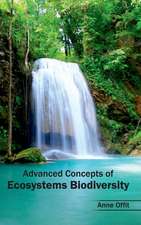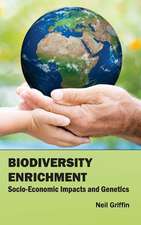Biodiversity and Earth History
Autor Jens Boenigk, Sabina Wodniok, Edvard Glücksmanen Limba Engleză Paperback – 18 oct 2016
| Toate formatele și edițiile | Preț | Express |
|---|---|---|
| Paperback (1) | 875.56 lei 6-8 săpt. | |
| Springer Berlin, Heidelberg – 18 oct 2016 | 875.56 lei 6-8 săpt. | |
| Hardback (1) | 1334.56 lei 39-44 zile | |
| Springer Berlin, Heidelberg – 30 apr 2015 | 1334.56 lei 39-44 zile |
Preț: 875.56 lei
Preț vechi: 1030.07 lei
-15% Nou
Puncte Express: 1313
Preț estimativ în valută:
167.54€ • 174.58$ • 138.72£
167.54€ • 174.58$ • 138.72£
Carte tipărită la comandă
Livrare economică 03-17 aprilie
Preluare comenzi: 021 569.72.76
Specificații
ISBN-13: 9783662516416
ISBN-10: 3662516411
Pagini: 415
Ilustrații: XIV, 401 p. 476 illus., 12 illus. in color.
Dimensiuni: 210 x 279 x 22 mm
Greutate: 10.07 kg
Ediția:Softcover reprint of the original 1st ed. 2015
Editura: Springer Berlin, Heidelberg
Colecția Springer
Locul publicării:Berlin, Heidelberg, Germany
ISBN-10: 3662516411
Pagini: 415
Ilustrații: XIV, 401 p. 476 illus., 12 illus. in color.
Dimensiuni: 210 x 279 x 22 mm
Greutate: 10.07 kg
Ediția:Softcover reprint of the original 1st ed. 2015
Editura: Springer Berlin, Heidelberg
Colecția Springer
Locul publicării:Berlin, Heidelberg, Germany
Cuprins
1. Introduction.- 2. Earth’s History.- 3. Distribution of present-day biodiversity and biomes.- 4. Mega systematics.- 5. Glossar.
Recenzii
“Each topic is dense with information, well organized, and the writing is clear. Although almost anyone with a bit of a biology and geology background will learn a lot about life on Earth, the text is replete with the scientific names of higher taxa, many of which will likely be obscure to all but specialists. Thus, the text, in general, is geared to the biologically and geologically literate.” (Joel Cracraft, The Quarterly Review of Biology, Vol. 91 (4), December, 2016)
“Each text page consists of an overview of a subject, followed by a deeper treatment, and includes a glossary of terms and cross-references to related book sections. The image pages are vivid, well labeled, and arresting. … This work is a useful reference at many levels, as well as a pleasure to browse. … Summing Up: Highly recommended. Lower-division undergraduates through professionals/practitioners.” (W. L. Cressler III, Choice, Vol. 53 (8), April, 2016)
“Its emphasis, as the title implies, is the evolution of biodiversity during the course of Earth history and it begins with a thorough documentation of the geological and chemical development of the planet. … The publishers deserve congratulations on the very high standards of production that greatly enhance the value of the book. In conclusion, this is a reference textbook that should be available to all students of Earth Sciences, Biology, and Biogeography.” (Peter Moore, The Bulletin, Vol. 46 (4), 2015)
“Each text page consists of an overview of a subject, followed by a deeper treatment, and includes a glossary of terms and cross-references to related book sections. The image pages are vivid, well labeled, and arresting. … This work is a useful reference at many levels, as well as a pleasure to browse. … Summing Up: Highly recommended. Lower-division undergraduates through professionals/practitioners.” (W. L. Cressler III, Choice, Vol. 53 (8), April, 2016)
“Its emphasis, as the title implies, is the evolution of biodiversity during the course of Earth history and it begins with a thorough documentation of the geological and chemical development of the planet. … The publishers deserve congratulations on the very high standards of production that greatly enhance the value of the book. In conclusion, this is a reference textbook that should be available to all students of Earth Sciences, Biology, and Biogeography.” (Peter Moore, The Bulletin, Vol. 46 (4), 2015)
Textul de pe ultima copertă
This uniquely interdisciplinary textbook explores the exciting and complex relationship between Earth’s geological history and the biodiversity of life. Its innovative design provides a seamless learning experience, clarifying major concepts step by step with detailed textual explanations complemented by detailed figures, diagrams and vibrant pictures. Thanks to its layout, the respective concepts can be studied individually, as part of the broader framework of each chapter, or as they relate to the book as a whole. It provides in-depth coverage of: - Earth’s formation and subsequent geological history, including patterns of climate change and atmospheric evolution; - The early stages of life, from microbial ‘primordial soup’ theories to the fossil record’s most valuable contributions; - Mechanisms of mutual influence between living organisms and the environment: how life changed Earth’s history whilst, at the same time, environmental pressures continue to shape the evolution of species; - Basic ideas in biodiversity studies: species concepts, measurement techniques, and global distribution patterns; - Biological systematics, from their historical origins in Greek philosophy and Biblical stories to Darwinian evolution by natural selection, and to phylogenetics based on cutting-edge molecular techniques. This book’s four major sections offer a fresh cross-disciplinary overview of biodiversity and the Earth’s history. Among many other concepts, they reveal the massive diversity of eukaryotes, explain the geological processes behind fossilisation, and provide an eye-opening account of the relatively short period of human evolution in the context of Earth’s 4.6 billion-year history. Employing a combination of proven didactic tools, the book is simultaneously a reading reference, illustrated guide, and encyclopaedia of organismal biology and geology. It is aimed at school- and university-level students, as well as members of the public fascinated by the intricate interrelationship of living organisms and their environment.
Caracteristici
Ease of learning and understanding by way of figure-based transfer of knowledge and straightforward learning units (each double page) Facilitated understanding of complex concepts drawing from an interdisciplinary array of traditional disciplines (Zoology, Botany, Microbiology, Earth History, Geology) Transfer of knowledge on multiple levels, from beginner to advanced Easy lateral entry into different subjects due to a subject-specific glossary and cross-references within each learning unit


















